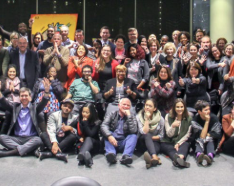As education continues to evolve in the digital age, a new model is gaining attention—crowd-learning. Unlike traditional learning environments that rely on centralized instruction, crowd-learning is driven by communities of learners who share knowledge, collaborate on problem-solving, and build expertise together. This approach is transforming how we think about who teaches, how learning happens, and where it takes place.
At its core, crowd-learning emphasizes peer-to-peer knowledge sharing. Learners contribute what they know, ask questions, and help others by offering answers, resources, or guidance. Platforms such as forums, online communities, and educational social networks support this model by enabling users to interact, exchange ideas, and create content collectively. Unlike hierarchical classrooms, crowd-learning is based on mutual participation, where every learner has the potential to be a contributor and a teacher.
One of the key benefits of crowd-learning is accessibility. With an internet connection and a willingness to participate, learners from around the world can access knowledge that was once limited to formal institutions. This model empowers individuals in remote or underserved areas to learn from global peers and contribute their own perspectives. It opens doors to knowledge outside the bounds of geography, socioeconomic status, or formal accreditation.
Crowd-learning also supports collaborative problem-solving. Whether it’s tackling a coding challenge, exploring a historical debate, or developing a business strategy, learners work together to find solutions. This real-time exchange of ideas mirrors real-world teamwork and builds skills that are essential in today’s workforce. It encourages learners to engage in constructive dialogue, defend their positions, and refine their understanding through feedback.
Another advantage is diversity of thought. In crowd-learning environments, learners are exposed to a wide range of experiences, cultural contexts, and viewpoints. This diversity enhances critical thinking and broadens understanding beyond what a single instructor or curriculum might provide. Exposure to global insights fosters empathy, adaptability, and a deeper awareness of different worldviews.
Technology plays a vital role in enabling crowd-learning. Platforms like Reddit, Quora, Stack Overflow, GitHub Discussions, and niche education forums provide the digital infrastructure for these interactions. Some online courses and MOOCs now include crowd-based elements such as peer reviews, discussion boards, live collaboration spaces, and user-generated resources that harness the power of the community. The integration of AI moderation and reputation systems helps maintain order and relevance in large-scale interactions.
Crowd-learning also encourages lifelong learning. Because participation is often informal and self-paced, learners can join or leave discussions as needed, follow topics that interest them, and explore subjects at varying depths. This flexible structure appeals to adult learners, professionals, and hobbyists alike. It transforms learning into an ongoing habit rather than a finite goal and supports continuous upskilling in fast-evolving industries.
Additionally, crowd-learning supports experiential learning and real-world application. For example, platforms like Stack Overflow are built around real problems faced by developers in their day-to-day work. Contributions to such platforms often require problem-solving, critical analysis, and collaborative refinement—essential skills that are transferable to the workplace. Learners are not just absorbing content; they’re actively contributing to its creation and validation.
Crowd-learning is also closely tied to the rise of open educational resources (OERs). Through platforms like Wikibooks, OpenStax, and Creative Commons repositories, users collaborate to create and improve free educational content. This aligns with the ethos of democratizing education and reducing dependency on costly, static textbooks.
Challenges do exist, including verifying the accuracy of shared information, managing misinformation, and ensuring constructive interactions. However, many platforms use upvoting, moderation, tagging, and expert contributions to maintain quality and civility within the community. Reputation systems help identify reliable contributors, while community guidelines promote respectful discourse.
Educators and institutions are also beginning to recognize the value of crowd-learning. Some integrate community-based projects or crowd-sourced content creation into their curricula. Others use crowd-learning to support flipped classrooms, encourage independent research, or deepen peer assessment strategies. The model complements formal education rather than replacing it, offering a new layer of richness and interactivity.
In conclusion, crowd-learning is more than a trend—it represents a shift in how knowledge is created, validated, and shared. By promoting collaboration, inclusivity, self-directed inquiry, and community ownership of learning, it offers a powerful complement to traditional education models. As digital communities continue to grow and technology advances, crowd-learning may well become a cornerstone of education in the future—empowering individuals to learn not just from institutions, but from one another.


